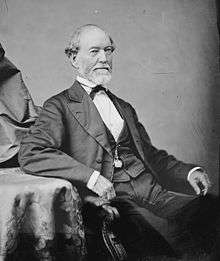James W. Flanagan
| James Winright Flanagan | |
|---|---|
 | |
| United States Senator from Texas | |
|
In office March 30, 1870 – March 4, 1875 | |
| Preceded by | Louis Wigfall |
| Succeeded by | Samuel B. Maxey |
| 11th Lieutenant Governor of Texas | |
|
In office 1869–1870 | |
| Governor | Vacant |
| Preceded by | George W. Jones |
| Succeeded by | Donald Campbell |
| Member of the Texas Senate from District 9 | |
|
In office 1855–1857 | |
| Preceded by | David Gage |
| Succeeded by | Malcolm D. Graham |
| Member of the Texas House of Representatives | |
|
In office 1851-1852 | |
| Personal details | |
| Born |
September 5, 1805 Gordonsville, Virginia |
| Died |
September 28, 1887 (aged 82) Longview, Texas |
| Political party | Republican |
James Winright Flanagan (September 5, 1805 – September 28, 1887) was an American merchant, lawyer, and farmer from Henderson, Texas. He served as the eleventh Lieutenant Governor of Texas in 1869 and 1870, and then represented Texas in the United States Senate from 1870 to 1875.
Early life
James was born to Charles and Elizabeth (Saunders) Flanagan in Albemarle County near Gordonsville, Virginia. Before his tenth birthday, the family moved to Boonesboro, Kentucky. As a young man he moved to Cloverport, Kentucky, on the Ohio River and became a prosperous merchant. He also read law and was admitted to the Kentucky bar in 1825. He married Polly Moorman in 1826 and the couple had several children before moving to Henderson, Texas, in 1844.
Career
Flanagan established himself in Henderson by opening a store. He bought a farm, speculated in land, and practiced law. Politically, he was a Whig and an active supporter of Sam Houston. He later became a moderate Republican. Flanagan served in the Texas House of Representatives (1851–1852) and the Texas State Senate (1855–1858).
When the Civil War came to Texas, Flanagan was a Unionist, but he withdrew to his farm and lived quietly. He returned to active politics during the Reconstruction. He served as a delegate to both Constitutional Conventions. The first, in 1866, produced a state constitution that was rejected by the Radical Republicans in the U.S. Congress. The second, in 1868–1869, was successful.
Under the new Constitution, Flanagan was elected Lieutenant Governor. He served there only until 1870, when Texas was readmitted to the Union. The legislature named him, along with Morgan Hamilton, to the U.S. Senate. He served one term as a Senator, until 1875 when he was replaced by the Democrat Samuel Maxey. In the Senate he was a supporter of the Grant Administration.
Later life
After his Senate term, Flanagan took up residence on one of his farms near Longview, Texas. He married again (he was widowed twice and married three times), this time to Elizabeth Lane. The three marriages produced a total of eleven children. One of Flanagan’s children was David Webster Flanagan who also served as Lieutenant Governor in Texas.
Flanagan died on his farm in Longview in 1887 and was buried next to his first wife, Polly, in their family graveyard in Henderson, Texas.
External links
- Biographic sketch at U.S. Congress website
- James Winwright Flanagan from the Handbook of Texas Online
| Texas Senate | ||
|---|---|---|
| Preceded by David Gage |
Texas State Senator from District 9 1855–1857 |
Succeeded by Malcolm D. Graham |
| Political offices | ||
| Preceded by George Washington Jones |
Lieutenant Governor of Texas 1869–1870 |
Succeeded by Donald Campbell |
| United States Senate | ||
| Preceded by vacant(1) |
U.S. Senator (Class 1) from Texas 1870–1875 Served alongside: Morgan C. Hamilton |
Succeeded by Samuel B. Maxey |
| Notes and references | ||
| 1. Because Texas seceded from the Union in 1861, seat was declared vacant from 1861 to 1870 when Louis T. Wigfall withdrew from the Senate. | ||


